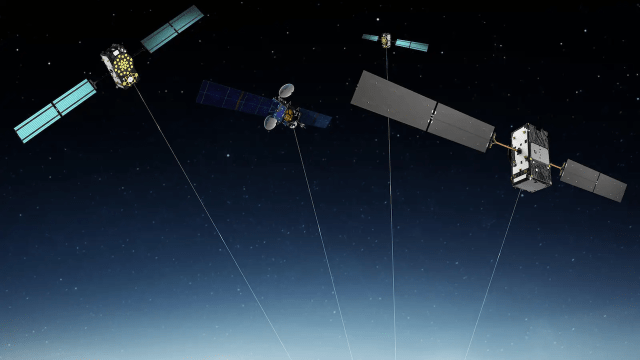The European Space Agency (ESA) plans to test new navigation satellites that will orbit much closer to Earth than those already in place, in an effort to deliver more accurate location data to our everyday devices.
Currently, Global Navigation Satellite Systems (GNSS) are typically placed in medium Earth orbits about (10,000 to 20,000 kilometres) above the surface and they send location data to smartphones, cars, and other mapping devices. But ESA is planning on building a constellation of navigation satellites, or satnavs, just a few hundred miles high, testing a multi-layer satnav system to supplement its already-existing Galileo satellites, according to ESA.
“Up until now the classical solution of GNSS such as Galileo…has been what we rely on for our positioning,” Lionel Ries, head of ESA’s GNSS Evolutions research and development team, said in the statement. “Standard GNSS alone is not going to be able to fulfil all these future user demands. Instead, Europe needs to seize the opportunity to investigate the potential of the kind of low Earth orbit (LEO) constellations that are already on the way in the global market to enable new kinds of Positioning, Navigation and Timing (PNT) services.”
The space agency will build and launch an initial mini-constellation of at least a half dozen satellites to test the technology. These satellites will be relatively small compared to the Galileo satellites, weighing about 150 pounds (70 kilograms) compared to 1,540 pounds (700 kg). “These satellites would also be built on a rapid batch production basis to save time and cost—we are targeting three years at the most from signing the contracts to the first satellites in orbit,” Roberto Prieto-Cerdeira, Galileo Second Generation satellite payload manager, said in the statement.
ESA will perform an in-orbit demonstration of the low Earth orbiting satnavs once they’re in place. By being closer to Earth, the satellites will have less distance to cover when delivering their signals. What’s more, the signals will be more powerful and reach places not otherwise covered by current satellites as the result of excessive interference.
Around 6.5 billion satnav receivers exist today and the sector is growing at a rate of 10 per cent every year, according to ESA. The space agency suggests that today’s navigation satellites will not be able to keep up with the growing demand.
“It is ESA’s ambition to ensure Europe maintains a world-class space industry, and navigation today forms the single largest downstream space sector,” ESA Director of Navigation Javier Benedicto-Ruiz said in a statement. “Standing still is not an option; instead we need to explore new technical avenues to spur European competitiveness and commercialisation.”
The space industry is finding new ways to benefit from Earth’s low orbit, which means this region is getting awfully crowded. There are around 140 satellites in medium Earth orbit, compared to a whopping 4,700 satellites in low Earth orbit, according to the UCS Satellite Database (which is current to April 30, 2022). The addition of another constellation of satellites will certainly not help the space traffic situation up there, as the risks of in-space collisions continue to escalate.
